






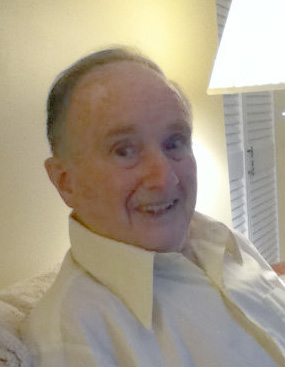
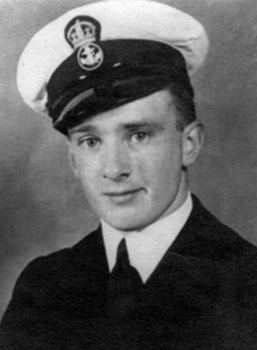
Les
Proctor grew up in Watford, lived in Garston and got to know the
Fighting Cocks, England's oldest pub, and the local of Bill Forster, the publisher of A Hard Fought Ship (2017) and writer of this introduction to Les Proctor's story of the sinking
of HMS Hecla and his rescue by HMS Venomous.
Les had wanted to join the Royal Navy since he was eleven and as a first step to becoming an Electrical Artificer
(EA) he took a job at the General Electric
Company at Wembley in 1937 to train as an Instrument Maker Improver. This was declared a "reserved occupation" and the Royal Navy
refused to take him when he tried to enlist on his eighteenth
birthday after the war started in 1939. He was only able to fulfill his
ambition and join the Royal Navy in June 1941 when he was 19 and had
changed his job to a non reserved occupation as an Instrument Maker at
Novabax Ltd.
After basic training at HMS Victory (Gosport and Portsmouth) and a six months electrical course at HMS Vernon (formerly Roedean College, Brighton, a girls school) and St Dunstans (a former home for the blind) he was drafted to HMS Hecla after its return from Iceland for a refit on the Clyde at Glasgow.
Events on the voyage south leading to Hecla being mined near Cape Town on the 15 May 1942 and spending five months under repair in drydock at Simonstown are described elsewhere on this web site. In October 1942 HMS Hecla
left Simonstown with Capt G.V.B. Faulkner RN in command to
support the Anglo-American invasion of North Africa, Operation Torch.
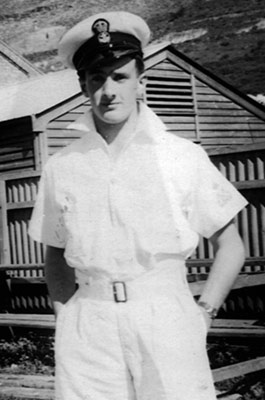
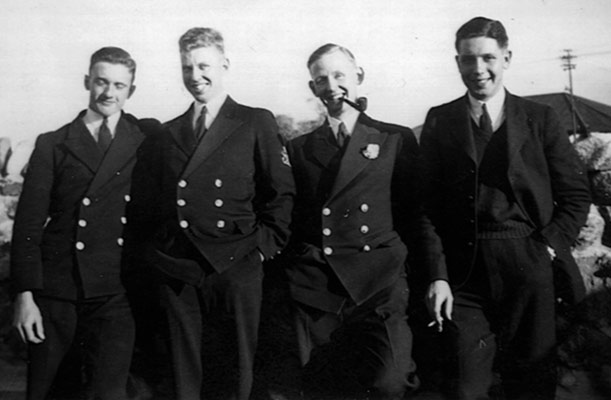
With help from Linda Clarke and his daughter Kathleen Ladouceur Les Proctor described what happened when HMS Hecla was torpedoed, in Chapters 2 and 3 of a self published spiral bound booklet My Experiences in the Royal Navy 1939-1946. This extract begins when the first torpedoes struck.
"At 23:30 on the 11 November when we were 35
degrees N, 9 degrees 55' W and approximately 150 miles from Gibraltar
we were hit by two torpedoes simultaneously. Cyril Hardware and I were
awake but in our hammocks and his only comment was "not again" (a
reference to us being mined). While we scrambled out and dressed a
sleepy head appeared from the only other hammock in the mess and
"Porky" Jennings asked why we were getting up! We went to action
stations and found that the boiler rooms had been hit and we were
without engines or power, and the ship had a large list. The diesel
generators, located in the engine room, were run up and power restored.
Pumps, etc. were activated and the ship was brought back on an even
keel.
HMS Vindictive passed us a
line to prepare for towing. Meanwhile, the EAs were frantically
restoring power to various services and some of us were in the engine
room operating circuit breakers. The engine room was on the hold deck,
approximately 20 feet below the water line. Also present were a rotund
stoker Petty Officer and a couple of stokers. Access to the engine room
was via a manhole hatch, oval in shape, held down by six clamps, and
not easy to access at any time.
At 00:22 on the 12th, while we were working at the far end of the engine room, another
"fish" came in for'ard and, despite the climb up a 20 foot ladder to
get through the hatch, we were all out within a minute, or so it
seemed. The stoker Petty Officer always had a squeeze to get through
the hatch but he went through with lifebelt and gas mask like a cork
out of a bottle.
Again the ship listed and two more "fish" came in at 00:32 and 01:05
but we (EAs) carried on running emergency cables connected to terminals
through the bulkhead at the deckhead. We started at the supply end and
connected live (220V DC) but as the ship took on a 45-degree list, we
eventually worked with one foot on the ship's side and the other on the
deck. When we had connected about half-way through the ship, an
Engineer Officer came by and said that "abandon ship" had been given
some time ago, it seems at approximately 00:15. Our Chief EA and the
Warrant Electrician plus a watchkeeper were at the switchboard, so I
went down to warn them and then joined Cyril on deck.
"Stepping In" 01:09
The drill for leaving a sinking ship is to run, walk or slide down the
high side to avoid being dragged under as the vessel rolls, so we made
for the high side. Discarding our boots and jackets, we went to the
rail but we both fell and slid down the wet deck. On the way, I hit the
legs of Flynn who was trying to work his way up. However, we all
finished up in a heap on the rail, which was then under water. Cyril
stood at the rail and ceremoniously dumped his cap and we all (Cyril
Hardware, Flynn, Allan Wardell, and myself) "stepped in" and started to
swim (my watch stopped at 01:09), agreeing to stay together. It was
pitch dark and there was a ten-foot swell so we could not see each
other but we saw the Marne by
the light of a star shell she sent up. We tried to keep in touch by
calling out but we were all being sick from taking in salt water and
fuel oil, and the last I heard was Alan Wardle saying he could not go
on. Cyril had said we ought to swim to the Marne,
a quarter of a mile away, but she received a "fish" in the stern and
the explosion doubled us up and showered us with debris. Cyril and I
both instinctively ducked our heads under water to avoid the chunks of
steel plate coming down. The Admiralty report states that a second
torpedo, presumably aimed at the Marne, missed, and hit Hecla. As we were still close to Hecla and a quarter mile from Marne,
we should have been affected by a second explosion seconds later, but I
only remember one explosion. As we did not wish to be caught between
two sinking ships, we turned and swam at ninety degrees. As it
happened, the Marne did not sink and was towed to Gibraltar the next day. Before being hit she had picked up about fifty survivors.
I swam on and found a Spanner raft, a cross hatch of wood about 18
inches square, but lost it soon after when another swimmer grabbed it.
I swam until dawn, about 07:00, when I saw a Carley float and hung onto
the ropes around it. They were made for 12 but this had many more and
was just submerged. After a while it overturned and, for a time, I sat
on it until it overturned again. As people died or disappeared, I
managed to stay with it and we helped to balance it against the
ten-foot swell. As the light improved, we caught glimpses of Venomous
picking up survivors but it was around noon before they got to us. This
was one of the worst parts of our time in the water as we had no way of
knowing whether the rescuer would ever come our way. All we could see
was the top of its masts when we rose to the top of a wave. As time
wore on the number on the float gradually reduced as cold, fatigue or
despair overcame them. The first time 1 heard the "death rattle" was stoker pensioner Tommy Totel who was then pushed away; it was depressing.
Rescue, 12:00, November 12
As the ship came alongside, we had to grab ropes or nets as she could
not stop and, thereby, present an easy target. I managed to grab the
scramble net but as my fingers, arms, and knees were locked, I could
not climb up, and two seamen reached down and hauled me aboard. Once on
deck, I could only move with bent knees. My only clothing was an
oil-soaked tropical shirt and underpants, the latter were "borrowed"
while I slept and they were drying.
Venomous ceased looking for survivors at 12:50 as no more could be seen and she was running low on fuel oil.
Questions were asked about the recovery of bodies. Venomous would have been a sitting target if it had stopped to retrieve bodies,
consequently, to avoid leaving them floating, they were machine gunned
to make them sink. I understand that the last survivors were picked up
some 23 miles from the point of sinking, i.e. a drift of about two
miles per hour.
A hero of the rescue was Herbert Button, the anti-submarine bosun of HMS Venomous,
who entered the water several times to assist exhausted survivors. He
became exhausted, retired to his bunk, lapsed into a coma and died a
few days later.
Venomous had a crew of 120 and picked up about 500 survivors, so you
can imagine we each had a stateroom! We were so crowded and tired, we
stayed where we were. The only person I recognised was a pensioner,
Charlie Meech, with whom I worked in the instrument section. You could
set the clock by him: workshop 08:00, tea 10:00, rum 11:00, leave for
dinner 11:50, head down 12:15, workshop 13:15, to "secure" at 15:50.
When Hecla sank, he abandoned
ship fully clothed, got on a Carley float and was picked up early. When
I saw him he was still fully clothed including collar, tie, and a cap,
dried out, and his only complaint was that his tobacco had gotten wet.
He had lost his entire watchmakers' equipment (the value in 1940 was
150 pounds for the lathe alone) but not a word about that.
Conditions aboard the rescue ship
As we were near the end of a two week voyage, there was little food
aboard so we could not be fed. Fuel oil was also low and, as we were
closer to Casablanca than to Gibraltar, we went there to take on fuel.
During the night passage, a spread of torpedoes was fired at us but,
fortunately, these were spotted and the spread "combed", i.e. the ship
turned to go between them.
We stretched out on the mess benches to sleep with the first fellow on
his back with his head at the end. Others then lay between his legs
resting their body on his stomach - this were the soft sleeping
accommodations. Due to the numbers, many had to sleep on the deck. When
the torpedo attack came during the night, the violent turn shot us all
onto the deck on top of those sleeping there. The crockery also smashed
on the deck. The lower mess deck is below the waterline and, had we
been hit, those in there would have had no hope, but those of us at
upper deck level may have escaped.
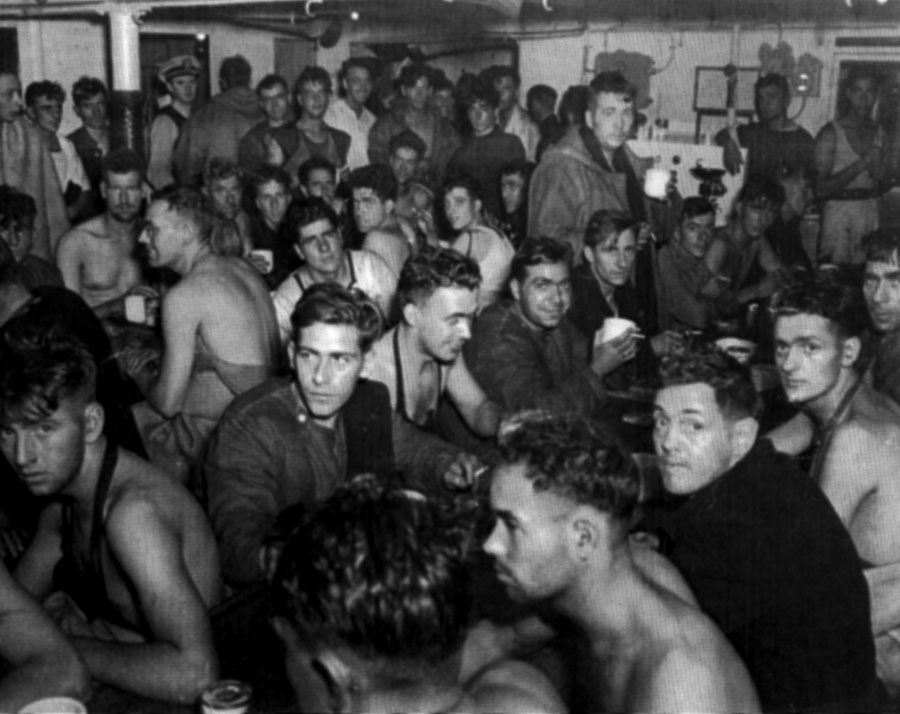
Arriving in Casablanca around 07:30 with only about four tons of fuel left (gauges showed empty), we were taken aboard the heavy cruiser, USS Augusta and given food and some clothing. I got a pair of socks, underpants, and drill trousers, after having been dressed in only my oil-soaked tropical shirt. That food tasted very good after 36 hours without. The landings in that area had just taken place and there was still fighting in the town and there were ships in the harbour on fire or sunk.
After refuelling we set out around noon. Outside the harbour
destroyers were circling, dropping depth charges and, as we crossed the
circle, a huge mushroom of oil came up following one depth charge drop.
The U-boat was hit.
Passage to England
We arrived in Gibraltar late evening and went to our respective messes on board HMS Duke of York
and "crashed" down on the deck. The following morning they gave us
their breakfast - bacon, eggs, and tomatoes - the first eggs these
people had received in three months. This was our first food in 24
hours. As we were heading for our mid-day meal at 12:00 we were piped
to muster on deck where we boarded tugs to go out to vessels for
passage back to England. We steamed around until 19:30, going from ship
to ship, until the liner Reina de Pacifico
agreed to take us. One vessel said we could come aboard but we would be
two decks below the Lascar messes, around bottom decks. This was
rejected. Once aboard the Reina de Pacifico we were allocated to cabins, between eight and twelve to each, but we received some food, our first since breakfast.
We sailed at midnight and, as the anchor was weighed, it banged on the
ship's side. One of us, a South African called Sjolander, was out of
his bunk, on deck, found the cause and back in the cabin before we
could get out - he had become very nervous.
Next day a raffle was held for a USAF bomber jacket (leather, lambswool
lined). Jennings won this with a shilling he "borrowed" from me (I
still have the belt in which I saved my money), so I bought it from him
for 30/- (£1 and ten shillings). I kept it until the late 1970s when I
gave it to Arve Bredahl, a friend in Saskatchewan.
Interestingly, Jennings, who had left the Hecla
in the prescribed manner by sliding down the higher side, found that
his buttocks and forearm had been badly lacerated by the barnacles but
the salt water had cauterized the cuts and stopped the bleeding."
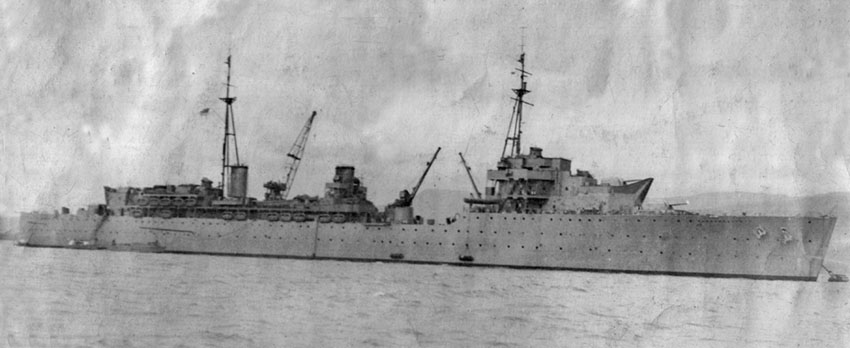
HMS Hecla on the Clyde after commissioning in March 1941
Bill Clayton survived the Hecla to serve on its identical sister ship, HMS Tyne
Courtesy of Simon Skelhorne
The Reina del Pacifico
berthed at Greenock on the 23 November and after walking barefoot over
cobblestones to a bombed out warehouse, they
were partly kitted up (Les was given a seaman's jersey, boots, a cap
and an oilskin coat). They were given a stew for dinner at noon and,
when the nearby "Wrennery" heard they had nothing more, sandwiches and
cocoa were brought at 21.00. They boarded a train at midnight for the
journey south to their barracks at Portsmouth.
*****
When Les returned from leave in January 1943 he was drafted to HMS Indomitable at Liverpool, an Illustrious
Class aircraft carrier commanded by P. Wooten-Wooten, known as "Peanuts" and other less polite names (he was not a
popular officer). After working up routines they left the Clyde in June
for the Mediterranean to cover the landings in Sicilly and Indomitable survived a hit from an air launched torpedo and spent ten days in Malta being "patched" before proceeding to Gibraltar. The Indomitable was sent to the US for repairs while Les returned to Londonderry on a corvette, his first experience of
life at sea on one of the smaller ships of the Royal Navy.
Les was posted to John Brown's shipyard, Clydebank, in October 1943 to
standby for the final building and commissioning of the aircraft carrier
HMS Indefatigable and it was there that he met and courted his wife, Catherine Macfarlane. Indefatigable joined the home fleet at Scapa Flow and took part in the attack on the Tirpitz in Altenfjord.
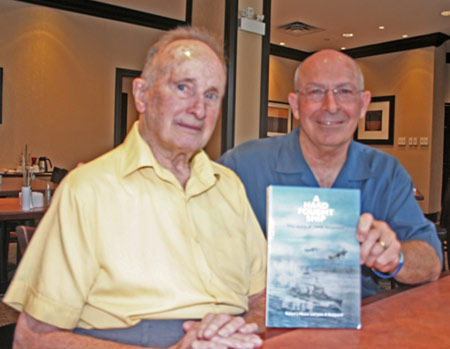 On 18 November HMS Indefatigable sailed
to join the British Pacific Fleet at Trincomalee in Ceylon where they
went on three week sorties to bomb oil fields on the Japanese occupied
islands of the Dutch East Indies. Indefatigable
spent Christmas in Australia and then joined the US Fifth Task Force in
covering the landings at Okinawa and
Sakashima
"during which they were repeatedly attacked by Japanese torpedo bombers
and kamikaze (suicide bombers)." One of these at Okinawa "scored a hit
on the flight deck at the base of the island, blowing a hole right
through but fortunately not damaging the boiler room smokestack. After
the islands were taken we withdrew to the Philippines, Manila Bay, and
effected our own repairs."
On 18 November HMS Indefatigable sailed
to join the British Pacific Fleet at Trincomalee in Ceylon where they
went on three week sorties to bomb oil fields on the Japanese occupied
islands of the Dutch East Indies. Indefatigable
spent Christmas in Australia and then joined the US Fifth Task Force in
covering the landings at Okinawa and
Sakashima
"during which they were repeatedly attacked by Japanese torpedo bombers
and kamikaze (suicide bombers)." One of these at Okinawa "scored a hit
on the flight deck at the base of the island, blowing a hole right
through but fortunately not damaging the boiler room smokestack. After
the islands were taken we withdrew to the Philippines, Manila Bay, and
effected our own repairs."
They patrolled the Japanese coast and
Formosa "while the atom bombs were delivered" and when Japan
surrendered "went into Tokyo Bay for the signing ... and met up with
HMS Duke of York carrying Admiral Tovey to accept the surrender on Britain's behalf and our captain sent a message to the skipper of the Duke of York 'Well done - we do the work, you take the glory'." Indefatigable
flew the flag in Australia and New Zealand and returned to Portsmouth
via Cape Town in March 1946 where it was decommissioned.
After
demobilisation Les returned to his pre-war job at Novabax, an unhappy
experience. His three children were born in Watford but Les moved to
Canada in 1955, obtained a job as an electrical engineer and the family
joined him the following year. His daughter, Kathy, lives in Ottowa and
visited him regularly. His oldest daughter, Valerie, lives in
Geneva and Douglas, the youngest member of the family, in Calgary.
In August 2012 Capt John Rodgaard USN (Ret), the author of A Hard Fought Ship,
visited Les in Ottowa and presented him with a copy of his book.
Armistice Day 2012 was the 70th anniversary of the torpedoing of
HMS Hecla when 273 men died and HMS Venomous rescued 493 of the survivors. Les Proctor lived a good life and was 94 when he passed away on 9 September 2016.